- Exclusive
- National
- NSW
- Development
Secret review to decide on removing ports for housing at Glebe Island
The state government has commissioned a secret review from a former NSW Treasury boss into whether the working ports at Glebe Island should make way for high-density housing in what would be a radical transformation of the harbour foreshore.
Michael Schur, who was Treasury secretary at the end of the last NSW Labor government, has been tasked with assessing options, including moving the ports, retaining them with no nearby housing, or building a hybrid model.
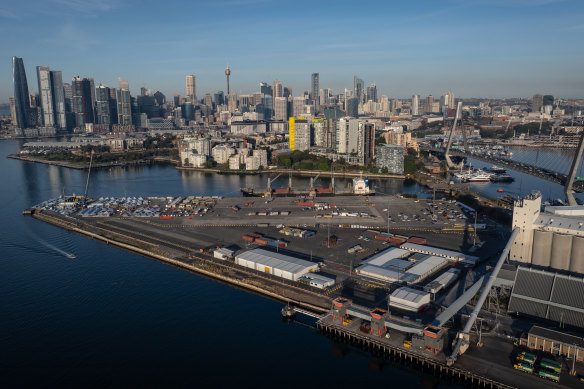
Port operations at Glebe Island, which receives large amounts of the state’s cement, gypsum and sugar.Credit: Wolter Peeters
The marinas at Rozelle Bay, on the other side of the Western Distributor, are also under the review microscope. Passenger cruise operations at White Bay are excluded and will remain.
A NSW government spokesperson confirmed the review was under way and said: “If the government has an announcement to make, it will be made at an appropriate time.”
The Bays West precinct has long been earmarked for more housing, commerce and cultural activity but the Minns government believes more density is warranted given the metro station due to open there in 2032.
The Port Authority of NSW, a state-owned corporation, is staunchly opposed to relocating its Glebe Island operations, which receive large amounts of the state’s cement, sugar and gypsum.
In a recent submission to the government’s Freight Policy Reform Program, it said moving to Port Kembla or Newcastle would be expensive, push up the price of commodities, generate hundreds of thousands of extra truck movements a year and increase carbon emissions.
The May 2024 document, now public, noted that more than 80 per cent of cement shipped to Glebe Island was distributed within 25 kilometres and used to build housing and infrastructure.
It said the port would probably “play an increasingly important role in supporting the government’s housing policy, with bulk commodities facilitating greater density in metropolitan Sydney”.
There was “no comparable space at the scale and proximity of that provided at Glebe Island to support government infrastructure programs”, and losing access to the port would “likely cause delays to delivery of new and upgraded critical infrastructure”.
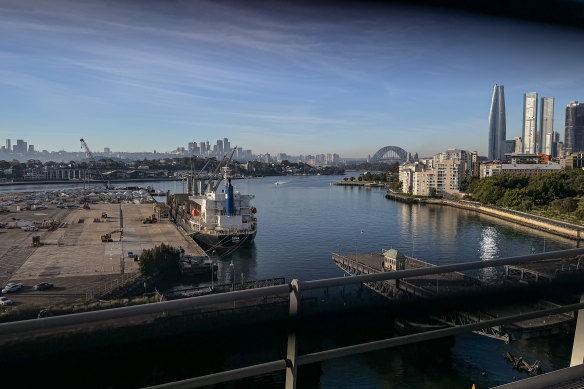
Tom Forrest, head of the Urban Taskforce developer lobby, said Bays West (left) could be Sydney’s next Barangaroo (right).Credit: Wolter Peeters
The Port Authority also warned against a hybrid of industry and housing at Glebe Island, saying “sensitive [land] uses” near ports and shipping threatened to upset operations. Noise, pollution and truck movements are all key considerations in whether the two can coexist.
Bays West is one of eight metro or heavy-rail sites the Minns government has designated as an “accelerated precinct” under its Transport-Oriented Development Program (TOD), meaning the state planning department has taken over master planning for the area.
Plans for the other seven sites, including Crows Nest, Kellyville and Homebush, are now on public exhibition, but the Bays plan has been delayed until mid-2025 while the port question is decided.
Schur, who is now a consultant, declined to comment on his ongoing report and referred inquiries to the Cabinet Office.
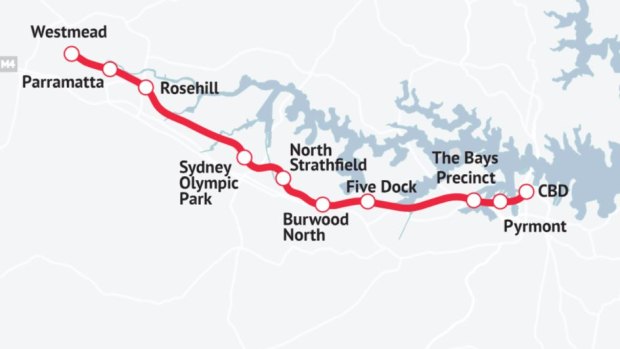
The new map of Metro West – estimated completion date 2032 – including the unconfirmed additional station in Rosehill.
A NSW government spokesperson said the Minns government had made clear its top priority was delivering more well-located homes near transport hubs across the state – including at Bays West.
“The former government commissioned a number of patchwork plans through different agencies that only delivered [capacity for] 250 new homes in stage one,” they said.
“The NSW government is now leading plans for the site, bringing together a number of agencies, and we’re committed to ensuring we have the most up-to-date evidence available.”
Placemaking NSW, Sydney Metro and the Transport Department, as well as the Port Authority, are all key stakeholders in the site. The Port Authority declined to answer specific questions but said it supported the stage one plans for residential development beside the metro station, as well as the government’s broader efforts to lift housing supply.
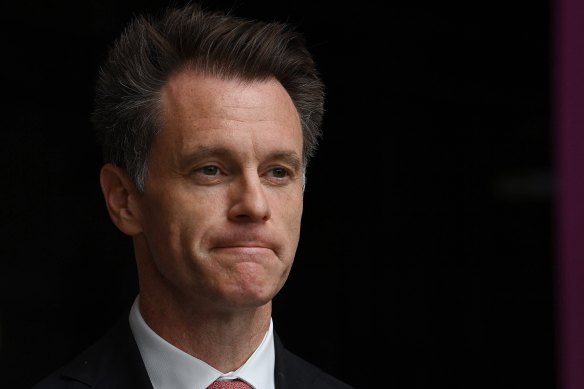
Premier Chris Minns has said delivering more housing in well-located areas is his government’s top priority.Credit: Kate Geraghty
Tom Forrest, chief executive of the Urban Taskforce developer lobby and a former Labor chief-of-staff, said the ports should be scrapped from Bays West entirely, arguing that the horse had bolted.
“Maintaining Sydney as a quasi-working harbour was a prospect that was abandoned by governments 30 years ago,” he said. “Continuing to operate a hybrid model ensures the Bays Precinct will fail to deliver its potential.”
Forrest said the site had the potential to be Sydney’s next Barangaroo – another former industrial port – which he described now as “vibrant, open and perfect”.
“That’s the sort of vision we need to see,” he said. “The last thing we want is to keep that giant hardstand area in order to satisfy the old Maritime Services Board.”
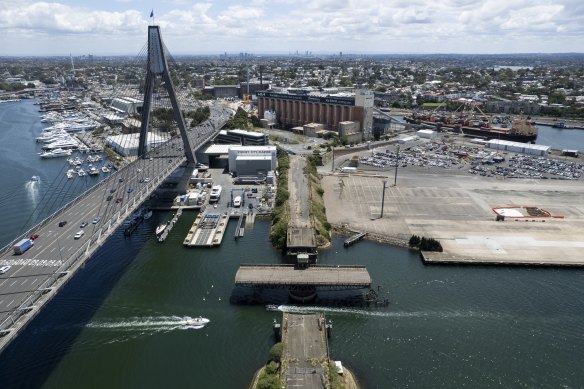
The marinas (left of the bridge) and the industrial ports (right of the bridge) are both part of the review.Credit: Brook Mitchell
But the industry is lobbying to stay, with Cement Australia arguing that any move would be “impractical and not sustainable”.
The company, which uses 16 former grain silos at Glebe Island as a cement terminal, wrote to Transport Minister Jo Haylen in April, noting its lease would expire at the end of 2030 and requesting an extension until 2050.
“Congestion and travel disruption caused by an approximate 34,000 additional vehicle movements from Port Kembla and Newcastle into Sydney CBD as well as the supply chain disruption ... would have a material cost impact on the $50 billion dollar[s] per annum NSW construction industry,” it contended.
In its submission to the freight view, the Port Authority of NSW estimated the price of gypsum and cement could rise by 50 per cent and sugar by 140 per cent if the ports had to move.
“Given the significant capital investment costs and additional operational costs, anecdotally sugar and cement have advised their NSW operations may not be viable ongoing and as such they would close,” it said.
The Planning Department’s website says community consultation on the Bays West rezoning plan will occur when it goes on exhibition in mid-2025. “The Bays West TOD will include staged master plans for the sub-precincts and track on a different timeline to the other TOD accelerated precincts due to the need to resolve working harbour and ports uses,” it says.
Start the day with a summary of the day’s most important and interesting stories, analysis and insights. Sign up for our Morning Edition newsletter.